
The index page for the 1954 French flap section of this website is here.
Reference for this case: 19-26-sep-54-Wulverdinghe.
Please cite this reference in any correspondence with me regarding this case.
In 1978, the ufological bulletin of the GNEOVNI Recherches Ufologiques, #4, indicated with reference to their own archive that in September 1954 around 10:30 p.m. in Wulverdinghe in the Nord department, Mrs. Decalf saw a sort of metallic structure sizzling like a swarm of bees and emitting intermittent lights; she got scared and ran away. She returned during the day but there was nothing left to see.
The same year in #6 of the GNEOVNI nulletin, we learn that the report is actually a letter from the witness, of which GNEOVNI did not give the writing date, and signed by Mme Decald-Eustace, 259 rue Montgolfier in Roubaix. She wrote:
"I had been in primary education for two years and I had just been appointed to a school in the countryside, in Wulverdinghe exactly, a small village of 500 residents, the nearest town of which is Watten which has a small train station. It was at this station that I arrived on a Sunday evening the day before the start of the school year around 9 p.m. Finding neither a bus nor a taxi to drive me, I therefore decided to go to Wulverdinghe by foot, having about 4km to walk in the night. I find myself at the exit of Watten on a departmental road, and in front of a fork, I inquire about the road to follow. I must continue on my way to a new junction then take a fairly wide dirt road, suitable for motor vehicles. I find myself in the countryside. The night is dark, but with a clear sky, without moon, without mist or fog. I arrive at the junction in question where there is a tavern on the left. I take this deserted dirt road, crossing fields. Halfway between the estaminet and Wulverdinghe I have about 1 km to walk, on the right in the open fields, I can see a sort of pylon close to the road, standing out against the night giving off a halo, emitting a weird noise and weird intermittent lights. Not knowing the country, I think I see a kind of small power plant. Approaching more and more and arriving at a distance of 30 to 40 meters from the object (it must have been around 10:30 p.m.), I stop, in awe. The pylon looks more like a tower or an angular sugar loaf, a kind of scaffolding of beams, it emits a sound resembling neither a motor noise, nor a humming, rather the sizzling of a swarm of bees (regularly uneven in intensity) approaching and moving away in turn. The pylon spurts sparks, its contours remaining imprecise in the dark night. At the base of this pylon there are dark masses that I take for tall bushes. I begin to feel a deep discomfort and a certain growing fear. I'm trying to see better, I'm getting closer. But the fear in front of this unusual machine makes me turn around and I find myself at the tavern, closed at this late hour, where I however try to find help by knocking on the door long and loudly, but in vain. I finally hit the road again, advancing cautiously. It must be past 11 p.m. I arrive at the suspicious place: there is nothing left, it is a field without trees and without lights. Subsequently, being in the country, I checked this field by day; then I would only see harvested fields or beet fields, no pylons or trees around."
In 1979, French ufologist Alain Gamard listed in a British ufology publication a case of "humanoid encounter", which would come from an article in the newspaper Nord-Matin of 1954. The witness would be a Mrs Decalf, the place would be Watten, and he said it occurred at 20:30 in September 1954.
In 2003, on the Web, ufologist Jean-Pierre D'Hondt, of the ufology group GERU in the Nord, told more: the GERU had received a letter from Mrs. Decalf-Eustace, 259, rue Montgolfier in Roubaix, dated November 18, 1969, in which she reported her observation of Sunday, September 19 or 26, 1954, in Wulverdinghe in the Nord department.
Mrs. Decalf-Eustace reported that she had been then a primary school teacher for two years and had just been assigned in the countryside in Wulverdinghe, 400 to 500 inhabitants, a village close to Watten.
The day before the start of the school year, one Sunday evening of September 1954, she arrived at the train station of Watten at about 08:30 p.m. or 09:00 p.m. and found neither bus nor taxi. She then decided to reach Wulverdinghe by foot, a distance of 4 or 5 km, and found herself at the exit of Watten on a small secondary road and in front of a junction, where she got information about the road to follow.
She had to walk to another junction, then take a dirt track, rather broad, fit for cars, on the left.
She found herself in the countryside under a black night but with a clear sky, without moon, nor mist, neither fog, arrived at the indicated junction, where there is a coffee shop on the left.
She started walking on this dirt track, crossing the fields and which was deserted, and halfway between the cofee shop and Wulverdinghe, whereas she still had approximately a kilometer to walk she distinguished on her right in the fields a kind of pylon, near to the road, being silhouetted against the night, releasing a halation, emitting a weird noise and weird intermittent gleams.
As she did not know the country, she thought she was seeing some sort of small power station. Approaching more and more and arriving at a distance of 30 to 40 meters of the object, whereas it had to be about 10:30 p.m., she stopped in amazement, becaise the pylon rather looked like a towe, or an angular "sugar loaf", a kind of scaffolding of beams, and it emits a sound not resembling an engine noise, nor a whirr, but rather the buzz of a swarm of bees of regularly unequal intensity, approaching and moving away in turn.
This pylon spouted sparks, its contours remained vague, and at the base of this pylon, there were dark masses that she thought were bushes.
She started to feel ill at ease and fear grew. She approached more for better seeing, "but the fear, facing this weird apparatus, makes me fo back, and I return to the coffee shop, closed at this late hour, where I however try to find help, knocking on the door a long time and loudly."
Nobody answerer her call, she ended up taking the road again, advancing with care, at about after 11 p.m., and arrived at the suspicious location, where there is nothing any more.
She later checked this field by day and noted that there were only harvested fields or fields of beets, but no of house, farm, or tree around.
[Ref. gni1:] GNEOVNI:

|
September 1954 - WULVERDINGHE 59 type I
Around 10:30 p.m. Mrs. Decalf saw a sort of metallic structure sizzling like a swarm of bees and emitting intermittent lights, the witness became afraid and fled. Back in the day nothing more remained.
(GNEOVNI Archive)
[Ref. gni1:] GNEOVNI:
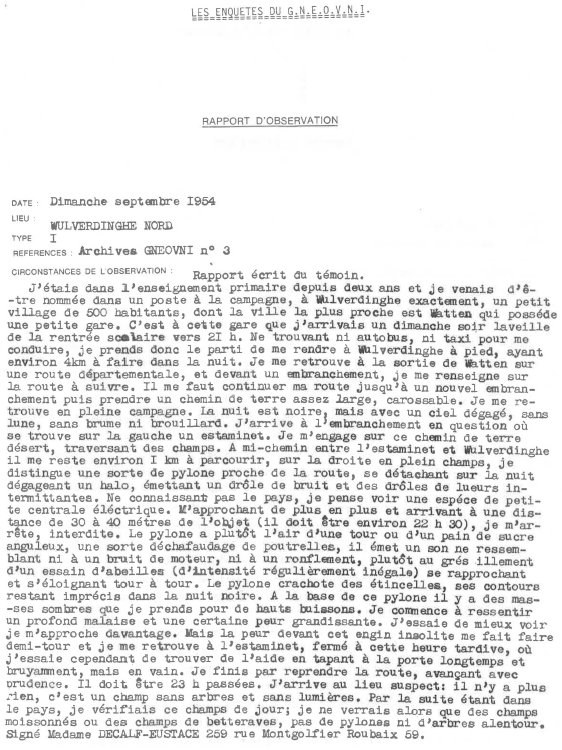
|
DATE: Sunday September 1954
PLACE: WULVERDINGHE NORD
TYPE I
REFERENCES: GNEOVNI Archive nr 3
CIRCUMSTANCES OF THE OBSERVATION: Written report of the witness.
I had been in primary education for two years and I had just been appointed to a school in the countryside, in Wulverdinghe exactly, a small village of 500 residents, the nearest town of which is Watten which has a small train station. It was at this station that I arrived on a Sunday evening the day before the start of the school year around 9 p.m. Finding neither a bus nor a taxi to drive me, I therefore decided to go to Wulverdinghe by foot, having about 4km to walk in the night. I find myself at the exit of Watten on a departmental road, and in front of a fork, I inquire about the road to follow. I must continue on my way to a new junction then take a fairly wide dirt road, suitable for motor vehicles. I find myself in the countryside. The night is dark, but with a clear sky, without moon, without mist or fog. I arrive at the junction in question where there is a tavern on the left. I take this deserted dirt road, crossing fields. Halfway between the estaminet and Wulverdinghe I have about 1 km to walk, on the right in the open fields, I can see a sort of pylon close to the road, standing out against the night giving off a halo, emitting a weird noise and weird intermittent lights. Not knowing the country, I think I see a kind of small power plant. Approaching more and more and arriving at a distance of 30 to 40 meters from the object (it must have been around 10:30 p.m.), I stop, in awe. The pylon looks more like a tower or an angular sugar loaf, a kind of scaffolding of beams, it emits a sound resembling neither a motor noise, nor a humming, rather the sizzling of a swarm of bees (regularly uneven in intensity) approaching and moving away in turn. The pylon spurts sparks, its contours remaining imprecise in the dark night. At the base of this pylon there are dark masses that I take for tall bushes. I begin to feel a deep discomfort and a certain growing fear. I'm trying to see better, I'm getting closer. But the fear in front of this unusual machine makes me turn around and I find myself at the tavern, closed at this late hour, where I however try to find help by knocking on the door long and loudly, but in vain. I finally hit the road again, advancing cautiously. It must be past 11 p.m. I arrive at the suspicious place: there is nothing left, it is a field without trees and without lights. Subsequently, being in the country, I checked this field by day; then I would only see harvested fields or beet fields, no pylons or trees around.
Signed Madame DECALF-EUSTACE 259 rue Montgolfier Roubaix 59.
[Ref. agd1:] ALAIN GAMARD:

|
September 1954: 20.30 hours. Watten (Nord).
Witness: Melle Decalf.
Refs: Nord-Matin, ?.?.1970.
[Ref. ger1:] G.E.R.U:
Ufologist Jean-Pierre D'Hondt of the GERU received a letter of Mrs Decalf-Eustace, 259, street Montgolfier in Roubaix, dated November 18, 1969, which reported her observation of Sunday September 19, or 26, 1954 in Wulverdinghe in the department of the Nord.
Mrs. Decalf-Eustace reports that she had been then a primary school teacher for two years and had just been assigned in the countryside in Wulverdinghe, 400 to 500 inhabitants, a village close to Watten.
The day before the start of the school year, one Sunday evening of September 1954, she arrived at the train station of Watten at about 08:30 p.m. or 09:00 p.m. and found neither bus nor taxi. She then decided to reach Wulverdinghe by foot, a distance of 4 or 5 km, and found herself at the exit of Watten on a small secondary road and in front of a junction, where she got information about the road to follow.
She had to walk to another junction, then take a dirt track, rather broad, fit for cars, on the left.
She found herself in the countryside under a black night but with a clear sky, without moon, nor mist, neither fog, arrived at the indicated junction, where there is a coffee shop on the left.
She started walking on this dirt track, crossing the fields and which was deserted, and halfway between the cofee shop and Wulverdinghe, whereas she still had approximately a kilometer to walk she distinguished on her right in the fields a kind of pylon, near to the road, being silhouetted against the night, releasing a halation, emitting a weird noise and weird intermittent gleams.
As she did not know the country, she thought she was seeing some sort of small power station. Approaching more and more and arriving at a distance of 30 to 40 meters of the object, whereas it had to be about 10:30 p.m., she stopped in amazement, becaise the pylon rather looked like a towe, or an angular "sugar loaf", a kind of scaffolding of beams, and it emits a sound not resembling an engine noise, nor a whirr, but rather the buzz of a swarm of bees of regularly unequal intensity, approaching and moving away in turn.
This pylon spouted sparks, its contours remained vague, and at the base of this pylon, there were dark masses that she thought were bushes.
She started to feel ill at ease and fear grew. She approached more for better seeing, "but the fear, facing this weird apparatus, makes me fo back, and I return to the coffee shop, closed at this late hour, where I however try to find help, knocking on the door a long time and loudly."
Nobody answerer her call, she ended up taking the road again, advancing with care, at about after 11 p.m., and arrived at the suspicious location, where there is nothing any more.
She later checked this field by day and noted that there were only harvested fields or fields of beets, but no of house, farm, or tree around.
[Ref. prn1:] PETER ROGERSON:
September 1954, 2030hrs.
WATTEN (NORD: FRANCE)
A 20 year old teacher, Mrs Decalf, saw an object emitting lights and sparks. Several little figures were seen near it. No traces were found
Alain Gamard, citing an undated 1970 issue of Nord Matin.
[Ref. prn2:] PETER ROGERSON - "INTCAT":
September 19 or 26 1954. 2045hrs.
WULVERDINGHE (NORD: FRANCE)
Mrs Decalf, a school teacher, was walking back to this village from Watten station, down a country track, when she came across a strange apparatus resembling an electricity pylon, where none should have been, about 1km before the village. It emitted weird noises and flashes of light, and a sound like the humming of bees. It its base were dark masses she thought were bushes. The thing resembled a sort of sugar loaf with a superstructure of lights. She ran back to the coffee shop in Watten, afraid, but it was closed, so, cautiously resumed her walk at about 2300hrs.. When she got to the scene there was nothing there. When she checked the next day, all that was there was a beet field, with no buildings in the area.
Evaluation - Gross suggests she may have wandered off the path she later went on and found a pylon
A checking on a map with the powerlines is the mean of determining if the witness could have lost herself in the night on the wrong path close to a power pylon.
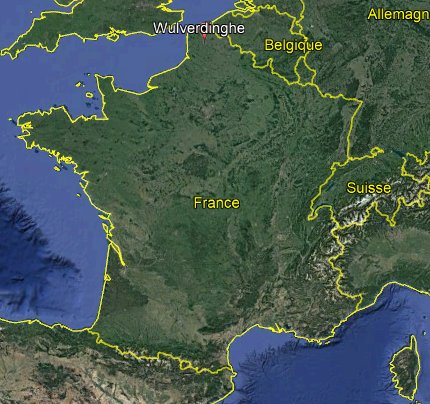
|
Mrs. Decalf strated by foor from the Watten train station to join Wulverdinghe:

|
She told she had to walk 4 km; which is strictly correct. At the exit of Watten on a departmental road, and in front of a junction, she asked about the road to follow, and she was told to continue until a new junction and take a fairly wide dirt road.
She arrived at the junction in question, and there was a tavern on the left; the place is easily located.

|
After the tavern, she takes a disrt road which crosses fields, and it is halfway between the tavern and Wulverdinghe, when she had another kilometer approximately to walk, that she saw the phenomenon, on her right, in the fields.
The journey is therefore ambiguous: either, at the second fork, she took rue de la Montagne on her left, or she took the route de Cassel on her right. The route de Cassel would be more logical, it leads to rue Principale in Wulverdinghe. If it took rue de la Montagne, then it must have taken what nowadays appears to be one or other of several carriage roads on its right, crossing fields and joining Wulverdinghe.
It doesn't matter after all: if my idea is correct, she got lost, that is to say that later she was unale to find a pylon because during the day when she checked, she did not take the same path she had taken at the time of the observation in the middle of the night. It is therefore a question of checking whether something like a pylon remains in 2020 in a field near one of the possible routes from Watten to Wulverdinghe and at a couple of kilometers from the finish.
And I did find a high voltage power line pylon, on the D226 aka "rue de la Montagne", on the right side of the street, and in a field, as in her report:
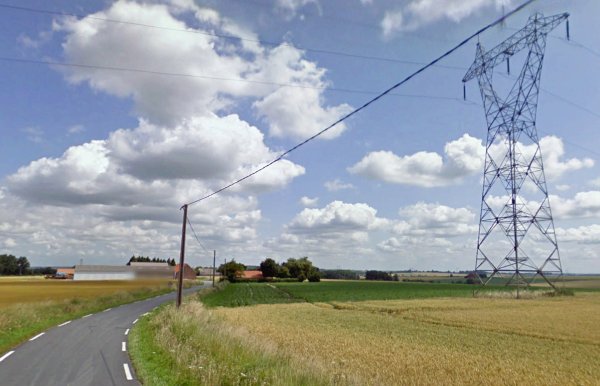
|
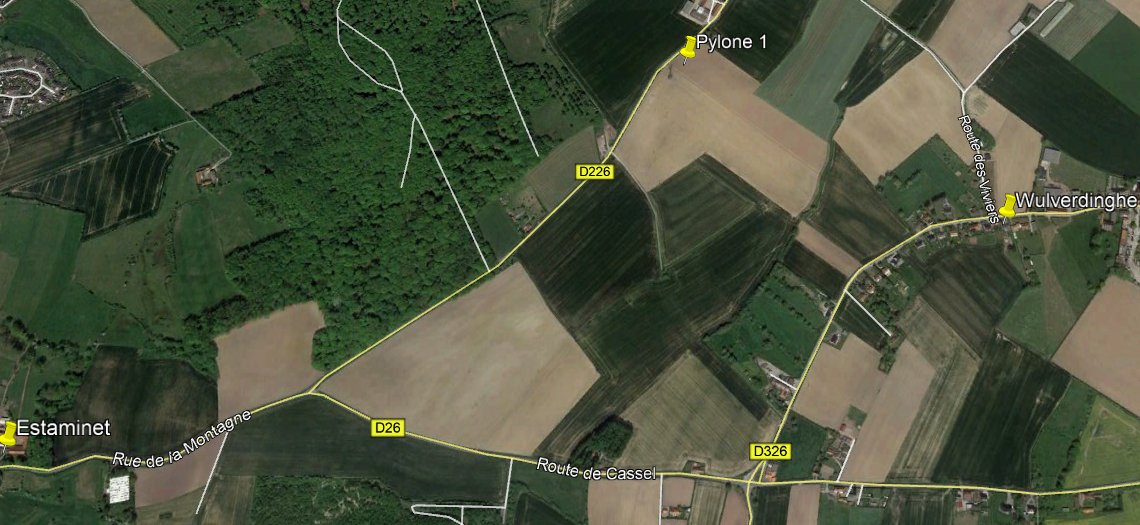
|
It is possible that during the night she passed near this pylon, and while looking for the place thereafter, she took the route de Cassel. I should note that from the route de Cassel, this pylon and two other pylons are visible by day in the distance (red lines below); but they are not only far away but also on the left, and there are none on the right, where she would have looked for what she had seen.
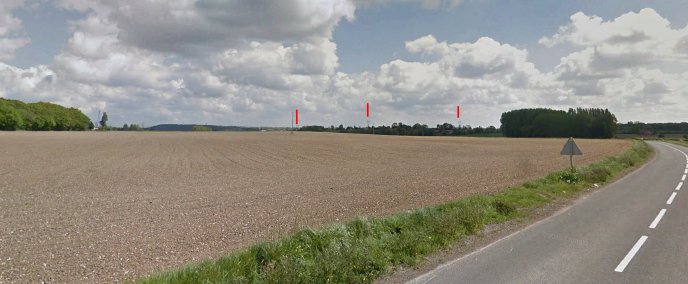
|
(These keywords are only to help queries and are not implying anything.)
Wulverdinghe, Nord, Decalf, Decalf-Eustace, night, single, pylon, tower, buzzing sound, sparks
[----] indicates sources that are not yet available to me.
| Version: | Created/Changed by: | Date: | Change Description: |
|---|---|---|---|
| 0.1 | Patrick Gross | First published. | |
| 1.0 | Patrick Gross | June 11, 2009 | Conversion from HTML to XHTML Strict. First formal version. |
| 1.1 | Patrick Gross | August 13, 2013 | Addition [prn1]. |
| 1.2 | Patrick Gross | September 26, 2019 | Additions [agd1], [prn2], Summary. |
| 1.3 | Patrick Gross | January 19, 2020 | Additions [gni1], [gni2]. In the Summary, addition of the paragraphs "In 1978,..." and "The same year..." and the letter quotation. Explanations changed, were "A checking on a map with the powerlines is the mean of determining if the witness could have lost herself in the night on the wrong path close to a power pylon." |